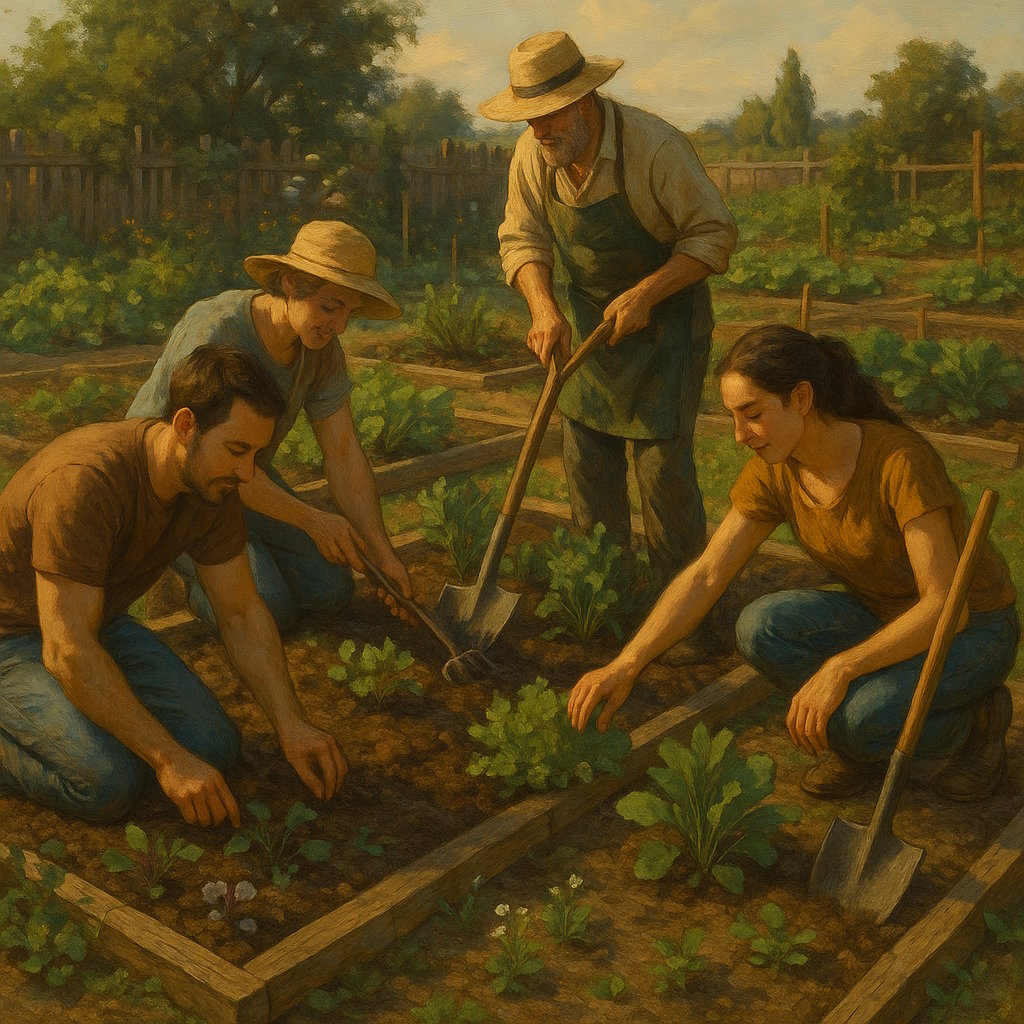In the last post, I shared a simple question:
On a normal Tuesday morning, do you enjoy being in your own life?
It’s a hard question to dodge. The Tuesday Morning Test strips away illusion and asks whether the life we’ve built is a life that fills us with meaning and purpose. It doesn’t measure our life while we’re sitting on a beach on vacation. It measures it right now.
For many of us, the answer is complicated. Maybe we’re proud of some parts. Maybe others feel overgrown. Maybe we’re trying our best with bad soil and broken tools.
Most people today focus on fixing THEIR garden, never realizing what’s missing. The real problem is that they’re gardening in isolation. That’s where the Tribe of the Fire comes in.
This post is about what happens when we stop pretending that individualism is working. It’s about what changes when we treat our lives like solitary gardens and begin tending them side by side. It’s about what happens when we share what we’re good at, we help each other survive the droughts, and we finally decide to say no more to curated isolation and performative success.
This is a different kind of community. It’s a community that feeds our most basic needs. Most people try to grow their life in isolation. Some plant things they don’t even like because someone else said they should. Others don’t plant at all; they inherited a plot already overrun with weeds, bad soil, and someone else’s priorities. Many never learned how to prune, or how to protect, or how to grow what they actually love.
Worse, they’re surrounded by other neglected gardens. No one shares tools. No one offers help. No one even walks the rows together. They grow their garden in isolation with the expectation they should know what they’re doing.
And then comes the poison of social media: an endless scroll of close-ups; someone’s perfect tomato, their overachieving sunflower, their pristine little bonsai of a marriage… all cropped and filtered to hide the rot just outside the frame. We compare our whole chaotic plot to their one photogenic plant and wonder what’s wrong with us. But what we’re seeing isn’t a real garden. It’s a lie of omission. Behind the camera, their weeds are just as thick. Their soil just as depleted. Their garden just as lonely.
That’s modernity, characterized by atomized people, hollow relationships, performative abundance and private droughts.
But it doesn’t have to be this way.
The Tribe of the Fire offers a different model. It functions like a community garden. It’s not a commune shut off from the world, it’s not a cult following some radical ideology, and not a utopian dream wrapped in false promises. It’s a network of like-minded people connected with the goal of making all of this better. Each person is responsible for their own garden bed, free to design and tend it as they see fit. But those beds grow side by side. What you grow best complements what I grow best. We do not compete. We contribute. And in that contribution, we stop trying to survive alone.
Maybe you’re great at growing carrots – deep work, grounded thinking, long-view strategy. I might be better at potatoes – durability, grit, mentorship. Someone else brings wild mint – laughter, creativity, spirit. In a Tribe COMMUNITY garden, we don’t compete. We complement. We trade what we have in surplus. We pass on what we’ve learned. We organize collectively to build irrigation, improve the soil, and keep out the goddamn raccoons of burnout and distraction.
There are still locusts, still droughts, and still plants that don’t take root. We can’t create a life without problems and obstacles.
But you don’t face those storms alone.
And that’s the difference.
Four Gardens of Modernity (and How the Tribe Fixes Them)
Most people didn’t choose their garden. They inherited someone else’s plan, followed the rules they were given, or simply reacted to pain the only way they knew how. The result? They built a landscape filled with frustration, burnout, and longing. These gardens might look different on the surface; some tidy, some wild, some overgrown with weeds, but underneath, they all suffer from the same core issue: disconnection. Disconnection from purpose. Disconnection from each other. Disconnection from the soul of the gardener. These are the common patterns of modernity, four ways we try to grow something meaningful in systems that were never designed to help us thrive. And this is exactly where the Tribe of the Fire begins its work, not with judgment, but with reclamation.
1. The Imitation Garden: This life looks “successful” from the outside. The job, the marriage, the vacations, the curated social media posts. But the soil is sterile. The plants are chosen to impress, not nourish. The relationship is passionless. The sex is transactional. The connection is dead.
How the Tribe heals it: The Tribe reawakens sovereignty. You’re not here to follow a script. You’re here to plant what matters to YOU. We teach people how to compost shame, reignite erotic polarity, and replace performance with purpose. You find the courage to replant your life, only truthfully this time.
2. The Abandoned Garden: This one has stopped planting. Maybe they were abused. Perhaps they were betrayed. They could be carrying trauma going all the way back to childhood. Or maybe they’re just deeply burned out. They withdrew, and their garden went wild with weeds. Apathy replaced hope. Sometimes the garden isn’t empty; it’s filled with invasive species: toxic partners, controlling families, emotional vampires.
How the Tribe heals it: The Tribe walks the rows with you. We lend hands when yours are too tired. We don’t shame you for weeds. We show you how to reclaim your soil, tear down the old fences, and start again. We remind you you’re not broken, you’re just not meant to do it alone.
3. The Extractive Garden: This garden is exploited. Built for someone else. Their labor is poured into dead systems: soulless jobs, loveless marriages, caretaking dynamics where nothing comes back. Maybe the partner is emotionally absent. Maybe they’re cruel. Maybe they haven’t touched each other in years. This gardener feeds everyone but themselves.
How the Tribe heals it: The Tribe doesn’t let people go hungry while feeding the machine. We model mutuality. We help you build relationships where reciprocity and reverence are the baseline, not the exception. We teach you how to stop giving everything away, and how to build connections that feed both people at once.
4. The Illusion Garden: This garden looks lush at first. Hypersexual. Hyperproductive. Hyperconnected. But dig beneath the surface and it’s all artificial light, synthetic soil, and chemically inflated blooms. These are porn-fed hookups, shallow friendships, self-help without sacrifice. No roots, intimacy, meaning. This is the garden of the hedonist. Fun, but devoid of purpose. This is the aging party animal we look at with a sense of pity.
How the Tribe heals it: The Tribe pulls people out of simulation and back into soul. We don’t optimize for dopamine. We build for devotion. We honor eros, but we root it in sacred fire. We restore polarity, presence, and the art of growing slow beauty that actually lasts.
The Tribe of the Fire is the Counter-Narrative.
We’re not a rejection of modernity, but a rewilding of humanity. We’re not a utopia, but a sanctuary for those who want to grow what’s real. We’re not a one-size-fits-all fix, but a place where your garden can finally belong.
Because our gardens were never meant to be grown alone.
Not on a Tuesday morning. Not ever.
~Jason


Leave a Reply